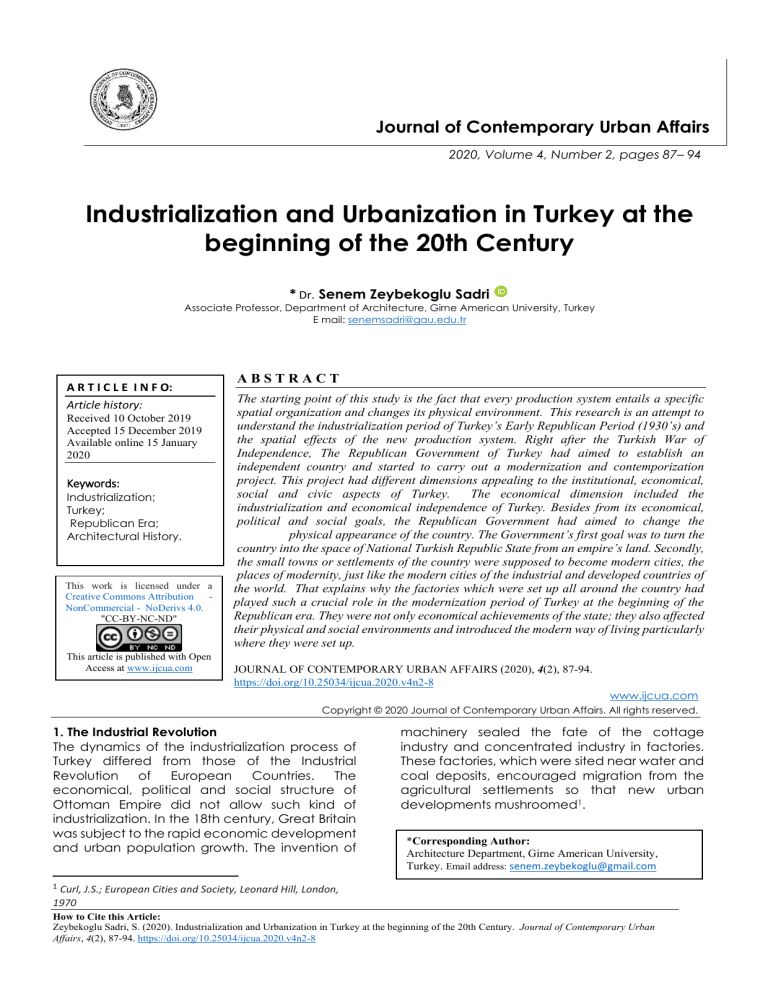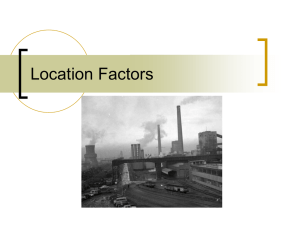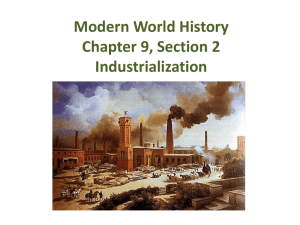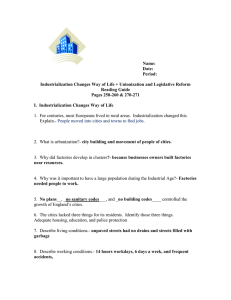
Journal of Contemporary Urban Affairs
2020, Volume 4, Number 2, pages 87– 94
Industrialization and Urbanization in Turkey at the
beginning of the 20th Century
* Dr. Senem Zeybekoglu Sadri
Associate Professor, Department of Architecture, Girne American University, Turkey
E mail: senemsadri@gau.edu.tr
A R T I C L E I N F O:
Article history:
Received 10 October 2019
Accepted 15 December 2019
Available online 15 January
2020
Keywords:
Industrialization;
Turkey;
Republican Era;
Architectural History.
This work is licensed under a
Creative Commons Attribution NonCommercial - NoDerivs 4.0.
"CC-BY-NC-ND"
This article is published with Open
Access at www.ijcua.com
ABSTRACT
The starting point of this study is the fact that every production system entails a specific
spatial organization and changes its physical environment. This research is an attempt to
understand the industrialization period of Turkey’s Early Republican Period (1930’s) and
the spatial effects of the new production system. Right after the Turkish War of
Independence, The Republican Government of Turkey had aimed to establish an
independent country and started to carry out a modernization and contemporization
project. This project had different dimensions appealing to the institutional, economical,
social and civic aspects of Turkey.
The economical dimension included the
industrialization and economical independence of Turkey. Besides from its economical,
political and social goals, the Republican Government had aimed to change the
physical appearance of the country. The Government’s first goal was to turn the
country into the space of National Turkish Republic State from an empire’s land. Secondly,
the small towns or settlements of the country were supposed to become modern cities, the
places of modernity, just like the modern cities of the industrial and developed countries of
the world. That explains why the factories which were set up all around the country had
played such a crucial role in the modernization period of Turkey at the beginning of the
Republican era. They were not only economical achievements of the state; they also affected
their physical and social environments and introduced the modern way of living particularly
where they were set up.
JOURNAL OF CONTEMPORARY URBAN AFFAIRS (2020), 4(2), 87-94.
https://doi.org/10.25034/ijcua.2020.v4n2-8
www.ijcua.com
Copyright © 2020 Journal of Contemporary Urban Affairs. All rights reserved.
1. The Industrial Revolution
The dynamics of the industrialization process of
Turkey differed from those of the Industrial
Revolution
of
European
Countries.
The
economical, political and social structure of
Ottoman Empire did not allow such kind of
industrialization. In the 18th century, Great Britain
was subject to the rapid economic development
and urban population growth. The invention of
machinery sealed the fate of the cottage
industry and concentrated industry in factories.
These factories, which were sited near water and
coal deposits, encouraged migration from the
agricultural settlements so that new urban
developments mushroomed1.
*Corresponding Author:
Architecture Department, Girne American University,
Turkey. Email address: senem.zeybekoglu@gmail.com
1
Curl, J.S.; European Cities and Society, Leonard Hill, London,
1970
How to Cite this Article:
Zeybekoglu Sadri, S. (2020). Industrialization and Urbanization in Turkey at the beginning of the 20th Century. Journal of Contemporary Urban
Affairs, 4(2), 87-94. https://doi.org/10.25034/ijcua.2020.v4n2-8
JOURNAL OF CONTEMPORARY URBAN AFFAIRS, 4(2), 87-94/ 2020
After the Enclosure Acts and the deprivation of
the yeomen of their ancient rights, the class
differences were accentuated, wealth being
concentrated in fewer hands, and the free men
and their families became the proletariat,
forming the labour factor of production. Rural
depopulation was caused by several factors, but
one which is often overlooked, was the fact that
the urban slums were probably a lot better than
the rural ones2.
2. The Social and Economic Structure of the
Ottoman Empire
During the 18th century, the Ottoman Empire
had appeared to carry the characteristics of a
pre-industrial economy; poverty, stagnation,
dependence
on
agriculture,
lack
of
occupational specialization and the low degree
of geographical integration3. The reasons for this
situation were the economic and social structure
of the Ottoman Empire. Firstly, the majority of the
population was formed of villagers, called as
“reaya”. They worked on the lands of the empire
and paid taxes, and they did not actually
constitute a class system. Secondly, the priority of
the land was belonging to Sultan, and the local
authorities (timar owners) of these lands were
only responsible to collect the taxes from the
reaya. They did not have the right to own land
because the Ottoman's land policies did not
allow any Enclosure Acts within the Empire. The
whole system of the government was established
on the gathering of surplus by the government
from the reaya, so that any event that could
possibly cause accumulation of capital was
prevented by the government4.
The economic development of the European
countries
also
affected
the
Ottoman’s
economical system. Firstly, the new trade ways
eliminated the Mediterranean trade ways, thus
the Ottoman Empire lost an important source of
taxes it gathered from the control of these trade
ways. Secondly, the metals like gold and silver
which introduced into European economy from
the New World had caused inflation and
increased the prices. Ottoman Empire turned
into a cheap source of food and raw material.
The Ottoman Empire had a stagnant economic
and social system which obstructed the flow of
money throughout the country. The low
population
rate,
the
production
which
2 Curl, J.S.; European Cities and Society
3 Curl, J.S.; European Cities and Society,
4 Kongar, E.; Turkey in the Twentieth Century: The Social
Structure of Turkey In the New Millenium, Remzi Publishing,
İstanbul, 1998.
5 Toprak, Z.; Ottoman Empire and Industrialization, The
Encyclopedia of Turkey Between the Periods of Ottoman
depended on agriculture or crafts and its locally
connectedness, and the insufficiency of
transportation and communication systems did
not allow the labour to transfer from agricultural
production to the activities concerned with
industrial production. As a result, the rural
population had no chance to move into urban
communities. On the other hand, there was no
demand for manufactures or services from the
society, because of the poverty and low
population, thus there had never been a
demand for a big capacity of industrial
production.
The only places which were
integrated with the world’s market system were
the harbour cities or the settlements which were
set up on the trade ways of the caravans. But the
hinterland of the Ottoman Empire could not
integrate with this system. The delay of
technological developments and education in
the country made it obligatory to transfer
specialists from European countries, and there
was a lack of occupational specialization.
Besides from these reasons, the social status of
the workers were always humiliated within the
paternalist structure of the guild system, and
being a soldier or an official for the government
had always been preferred to being an industrial
worker by the society members5.
Table 1. The number of factories and workers according to
the statistics of 1913-19156.
The
Production of
the factory
1. Food
2. Earth
3. Leather
4. Wood
5. Weaving
6. Paper
7. Chemistry
Number
of Number
of
Factories
Workers
1913
1915
1913
1915
76
20
12
19
75
55
12
78
21
13
24
78
55
13
4281
980
930
705
7765
1897
417
3916
336
1270
377
6763
1267
131
3. The Industrialization Process of Turkish
Republic
At the beginning of the Republican Era of Turkey
(1920’s), most of the consumer goods were
imported from other countries. The world’s
Financial Crisis at the beginning of the 1930’s
Reformation and Turkish Republican Era, İletişim Pub., İstanbul,
1985.
6Ökçün , A.G.; Statistics of Ottoman Industry Between the Years
1913-1915, T.C. Prime Ministerial State Institute of Statistics,
Ankara, 1998.
Dr. Senem Zeybekoglu Sadri
88
JOURNAL OF CONTEMPORARY URBAN AFFAIRS, 4(2), 87-94/ 2020
affected Turkey’s economy as well. The effects of
the crisis on Turkey’s economy were the
deterioration of international terms of trade, the
decrease of exportation and the decrease of
government’s budgetary incomes. The most
important source of income of Turkish economy,
the agricultural exportation, was becoming less
profitable during this period, and the idea of
industrialization was becoming more charming
each day7.
The new Republican Government had aimed to
develop the country and provide its economic
independence by introducing contemporary
industrial production. Thus, the private sector had
been granted many privileges in order to realize
the industrialization process of Turkey, but due to
lack of enough experiment and capital, and the
untrustworthy situation of the economic crisis of
the day, the private sector could not handle this
project8.
At the beginning of the 1930’s, the government
decided to undertake the economical course of
Turkey, by introducing many legislations and new
applications. This was also one of the results of the
state ruling policy of the government. One of the
most important applications of this period was
“The First Five Year Industrialization Plan”9 of
Turkey, which had been prepared during 1932
and put into practice in 1934.
To find technical and financial support for the
government’s new economic policies, the Prime
Minister İsmet Pascha (İnönü) visited many
countries like Soviet Union and Italy, in 1932. At
the same year, a group of Soviet technicians
came to Turkey to make surveys about the
investigation programme of Turkish government
and at the end of the year, the group presented
a report to the government.
But the government was not contented with this
report and in 1933, a group of American
specialists, in which the famous American
economist Edwin Kemmerer had participated,
was invited to Turkey. These specialists prepared
a detailed report on Turkey’s economic
conditions, natural sources, capital resources,
industry, transportation system, national and
international trade system, money and banking
system, foundations, working conditions, health
and
education
system,
and
public
administration. They presented their report to
Ministry of Economy in 1934. These researches
forecasted that it could be possible to set up
factories in Turkey more profitable than other
countries of the world10.
These reports of Soviet and American Specialists
determined the contents and form of the
investment programme of Turkish government.
Most of the projects were supposed to be
realized with the financial support of Soviet Union.
However, the priorities of the governmental
capitalism were different from those of the
realities of capitalist thinking during the
realization of this plan. Instead of assembling at
certain points of the country, the factories were
dispersed throughout the country11. According to
the plan, many factories producing consumer’s
goods were set up among Turkey’s many
different regions.
7 Tezel, Y.S.; The Economical History of Republican Era of
Turkey, Tarih Vakfı Yurt Pub., İstanbul, 1994
8 Kepenek, Y., Yentürk, N.; The Turkish Economical System,
Remzi Pub., 1996
9 İnan, A.; The State Ruling Period and the The First Five Year
Industrialization Plan of Turkey, 1933, Türk Tarih Kurumu
(Institute of Turkish History), Ankara, 1972
10 Tezel,Y.S. ; The Economical History of Republican Era of
Turkey, Tarih Vakfı Yurt Pub., İstanbul, 1994
11 The Iron-Steel Factory of Karabük was set up far from the
natural sources of charcoal and iron, just because of military
decisions. Kessler G.; The Working Conditions of KarabükZonguldak, Ankara University Journal of Faculty of Economy,
1948
12 Tayanç, T.; 50 Years of Industrialization Process, Milliyet
Pub., 1973.
Table 2. The factories and their regions, (Tayanç, 1973)12
Region
1. Marmara Region
İstanbul
İzmit
Gemlik
d. Bursa
2. Agean Region
Kütahya
Nazilli
c. Bodrum
3. Mediterranean
Region
Keçiborlu
Isparta
4.
Black
Sea
Region
Kastamonu
Karabük
5. Middle Anatolia
Region
Ereğli
Kayseri
6. Eastern Anatolia
Region
Malatya
Iğdır
The production of the
factory
cotton, glass
paper,
cellulose,
phosphate, sulphur
artificial silk
merino wool
ceramics
cotton
sponge
sulphur
oil of rose
hemp
iron-steel
cotton
cotton
cotton
cotton
Dr. Senem Zeybekoglu Sadri
89
JOURNAL OF CONTEMPORARY URBAN AFFAIRS, 4(2), 87-94/ 2020
This Industrialization plan was not only an
economical plan but also put into practice the
spatial strategies of the modernization project of
the Republican Government13. The places for the
factories were chosen among the small cities or
towns of Turkey which laid on the railway system,
so that even the smallest settlement could take
the advantage of the factory and its services.
The factories yielded employment, increase of
population, industrialization and as a result
urbanization of the small towns-settlements
where they had been set up.
These factories resembled the company towns of
Europe and America which firstly occurred in the
19th century. A company town was a community
inhabited by the employees of a single company
or groups of companies which also owns a
substantial part of the real estate and houses14.
These company towns were the challenges of
the paternalist investors against the intolerable
conditions of living and the new values system of
the new industrial era.
Pullman in the United States of America is a good
example for the company towns. It was a healthy
and rational environment with its well organized
plan. It was not only an industrial complex, but
also it was offering a new way of life with its
accident insurance, a company doctor, a school
system, athletic clubs, a company band, social
and educational clubs for workers.
Saltaire in Yorkshire (1860) was another important
company town, with its district social rules and
clear landscape planning. The factory building
and the church are just opposite of each other.
On the main axial road of the settlement lies the
factory schools, club and institute buildings.
Behind these buildings, there are the workers
houses15 .
In Turkey, the factories, the new production
system, put their effects on the economic and
social structure of the community, and also on
physical environment. Firstly, the people who
used to earn their livings by agriculture or crafts,
began to learn how to work in a factory system,
from turning the machines on, to coming to work
on time, or from living in mass houses of factory
to negotiating for their salaries. They began to be
the members of a working class, not only a family
or a tribe. The workers coming from the rural
areas of Anatolia to the settlements where the
factories were set up caused an increase of
population and that was the first and a very
13
Tekeli, Urban Planning in Turkey as a Modernization Project
14 Crawford, M.; Building the Workingman’s Paradise, The
Design of American Company Towns, London, UK, New York,
USA; Verso, 1995
important step for urbanization. The increase of
population necessitated new houses, new
services and new recreational facilities all
through the settlement. The industrial production
also revitalized the economic structure with its
demand for raw material and small industrial
production. Secondly, the factory complexes,
with their grid layout plans, housing units for
workers, social services, infrastructures and
recreational areas, introduced a new kind of
building type into the small and rural settlements
of Anatolia. These services of the factory also
affected the urbanization process of the
settlements.
These complexes were not only the spaces of
production, but also they served as the cultural
centres and gathering places for the community.
As women started to work at the factories, they
became the active members of the social life.
The social activities organized by the factories
(among these the celebration parties of the
national ceremonies, sports activities, theatre
performances, reading and writing courses for
non-readers can be listed) played an effective
role in the education of people. The people
living in the town were able to use the green
areas of the factory for recreational activities. By
that means, the factory complex served also as
a public space where people could meet with
each other, educate, recreate, and took the
advantage of many services. Those were the first
steps of a community towards a modern way of
life through the factories, which introduced them
the industrial production system.
Here two of these factories are compared with
each other according to their spatial properties.
One of them is the “Sümerbank Nazilli Basma
(printed cotton cloth) Factory”, which was set up
between the years 1935-937. This factory was a
very important step of the First Five Year
Industrialization Plan, as it was one of the first
factories that was realized and began
production. The plans of the factory were drawn
by a Soviet firm “Turkstroj”, and during the
building of the factory, engineers from the Soviet
Union worked in Turkey, both to build the factory
and to educate Turkish engineers and workers.
Another factory is “Sümerbank Kayseri Weaving
Factory” which was opened in 1935. Kayseri
factory was also set up by the technical and
financial support of the Soviet Union16. The plans
of the two factory buildings are very similar to
each other.
15 Kostof, S.; The City Shaped, Urban Patterns and Meanings
Through History, London, Thames and Hudson, 1991
16 İnan, A.; The State Ruling Period and the The First Five Year
Industrialization Plan of Turkey, 1933, Türk Tarih Kurumu
(Institute of Turkish History), Ankara, 1972
Dr. Senem Zeybekoglu Sadri
90
JOURNAL OF CONTEMPORARY URBAN AFFAIRS, 4(2), 87-94/ 2020
When we take a look at the layout plans of the
factories, we observe a rational grid system, and
very huge buildings which oppose with the
organic and traditional layout of the small towns.
This is because an industrial landscape is a direct
Figure 1. The Sümerbank Nazilli Basma Factory 1934, the
original plan drawing, Factory Library.
translation of the technical and social necessities
of a particular method of industrial production
into a settlement form17. The factories are
connected to the main railway system with a
narrow gauge railway where possible. This
maintained the transportation of raw materials
and the products of the factory, and also served
to carry the workers to factories in some places.
Both of the factories are symmetrical in planning
and a hierarchy is visible among the building
groups. The production units of the factories are
located at the centre of this hierarchy, after them
are the administration offices, and the residential
units of the administrative staff in the boundaries
of the factory settlements. The workers houses
had been added by time in case of need, and
they are located just opposite of the factory. The
infrastructure of the factories like power station or
water plumbing system served the whole town.
Other services and facilities of the factories
included health care centre, primary school,
nursery centre, cinema, sports complex, library,
fire station, and a restaurant which could be
used as an assembly hall.
These two factory buildings were built with steel
frame and concrete, which were the most
contemporary building technologies of their era.
The buildings are, simple and functionalist
buildings, which reflect the modernist tendencies
of the of 20th century’s industrial production
systems. When we take a look at the production
units of the factories, we can even observe the
effects of the Russian Constructivism on these
Figure 2. the general view of Kayseri Factory, on the left the
weaving ateliers (1930’s).
buildings (the combination of rational elements
in harmony to form a unity18).
4. Conclusion
The Industrialization of Turkey in the Early
Republican Period was an attempt to build up an
economically
independent
and
modern
country. After war of independence, the
government had to undertake the economical
course of Turkey, and the First Five Year
Industrialization Plan was a successful application
of the government during this period, because all
the projects that had been intended in this plan
were realized, either with national or out coming
budgets.
This industrialization process differed from the
“Industrial Revolution” of European countries
during the 18th and 19th centuries and had its
own social and economical dynamics. Firstly, the
economical activities of the Ottoman Empire
were depended on agriculture and crafts and
the only factories limited in number were
producing for the army. Thus, the industrialization
of the whole country was a new situation for the
Republican government and the public.
Secondly, the population was very low with the
effects of wars, and stabilized to rural settlements,
and the beliefs and traditions of the community
were not appropriate to form the immobile
society which the industrial production system
needed. The insufficiency of the transportation
system was another reason for this. Thirdly, the
factories were not private investments, they were
the investments of government, so the
industrialization process of Turkey could not be
named as a public wide “revolution”, it was only
a governmental policy applied during a limited
time and with limited resources.
In addition, there had been a sudden change in
the governing of the country and parallel with
the policies of the modern government, the
factories changed the socio-economical
structure of the society and affected the physical
environment of the settlements where they had
been set up. The increase of population and the
development of the economic activities
depending on the demands of the factory and
production for and integrating with the world’s
market system caused the urbanization of these
settlements. The cities took their shape according
to these factories and new industrial sites and
new neighbourhoods surrounded the factories.
The social activities organized by the local
authorities and the administrations of the
factories gathered the public together and these
17 Crawford, M.; Building the Workingman’s Paradise
18
Iakov Georgievich Chernikhov’s explanation of the principles
of Constructivism.
Dr. Senem Zeybekoglu Sadri
91
JOURNAL OF CONTEMPORARY URBAN AFFAIRS, 4(2), 87-94/ 2020
were new kinds of activities for a previously
agricultural
community
(including
sports
activities, theatre performances, cinemas, the
celebrations of the public days, libraries, reading
and writing courses).
But the success of this period could not be
sustained long. Especially after 1950’s, the
factories began to lose their effectiveness, and
most of them are closed now. Luckily enough,
the above mentioned factories are now
properties of two different state universities. The
buildings and the land of “Nazilli Basma Factory”
was purchased by Aydın Adnan Menderes
University and there are some projects prepared
by the municipality of Nazilli to turn these places
into a techno-park. The Weaving Factory of
Kayseri became the property of Erciyes University
in Kayseri, and the university is planning to
change some of the buildings of factory into a
campus for the university.
With above mentioned effects of the factories, it
can be said that the government’s spatial goals
concerned with the towns and cities of Modern
Turkey were realized particularly, where the
factories were set up. The modernization process
of these towns depended on industrialization
and urbanization. Therefore, these factories
exemplify spatial forms of new means of
production, which on the last analysis changed
the social aspects. In other words, these were the
factories that produced “cities”.
Acknowledgement
This research did not receive any specific grant
from funding agencies in the public, commercial,
or not-for-profit sectors.
Conflict of interests
The Authors declare no conflict of interest.
References
Ahmad, F. (1993) the Making of Modern Turkey.
Routledge Publications, London.
http://psi301.cankaya.edu.tr/uploads/files/Feroz
%20Ahmad%20Making%20of%20Modern%20TR(1
).pdf
Aru, K.A. (1998) Turk Kenti, YEM Pub., İstanbul.
https://www.worldcat.org/title/turk-kenti-turkkent-dokularinin-incelenmesine-ve-bugunkukosullar-icinde-degerlendirilmesine-iliskin-yontemarastirmasi/oclc/862318536
Aslanoğlu, İ. (1980) Erken Cumhuriyet
Mimarligi,
METU
Publications,
Donemi
Ankara
https://books.google.com.cy/books/about/Erken_c
umhuriyet_d%C3%B6nemi_mimarl%C4%B1%C4%9F
%C4%B1_19.html?id=4Ag_AAAACAAJ&redir_esc=y
Benevolo, L. (1967) The Origins of Modern Town
Planning, Cambridge, Mass: M.I.T. Press, 1967
https://mitpress.mit.edu/books/origins-moderntown-planning
Bilgin, İ. (1998) Modernleşmenin ve Toplumsal
Hareketliliğin Yörüngesinde Cumhuriyet’in İmarı.
In Y. S. ed., 75 Yılda Değişen Kent ve Mimarlık (pp.
255-272). İstanbul: Tarih Vakfı Yayınları.
https://tarihvakfi.org.tr/kitap/75-yilda-degisenkent-ve-mimarlik/307
Crawford, M. (1995) Building the Workingman’s
Paradise, The Design of American Company
Towns London, UK; New York, USA, Verso.
https://books.google.com.cy/books?id=0tePM56xzUC&printsec=frontcover#v=onepage&q&f=false
Curl, J.S. (1970) The European Cities and Society,
Leonard Hill, London.
http://www.jamesstevenscurl.com/james-stevenscurl-complete-works
Frampton, K. (1992) Modern Architecture, a Critical
History,
London,
Thames
and
Hudson.
https://www.worldcat.org/title/modernarchitecture-a-critical-history/oclc/25838861
Giddens, A. (1993) Sociology, Cambridge [England]:
Polity
Press.
https://catalogue.nla.gov.au/Record/2798984
Giedion, S. (1967) Space, Time and Architecture: The
Growth of a New Tradition, Harvard University
Press, Cambridge.
https://www.hup.harvard.edu/catalog.php?isbn=97
80674030473
Goodman, D., Chant, C. (1999) European Cities and
Technology, Industrial to Post Industrial City,
Routledge, London.
https://trove.nla.gov.au/work/32580846?q&version
Id=46568242
Hobsbawm, E.J. (1998) Sanayi ve Imaparatorluk, Dost,
Ankara.
http://www.dostyayinevi.com/TR/belge/1347/sanayi-ve-imparatorluk.html
Hobsbawm, E.J. (2000) Devrim Cagi, Dost. Ankara.
http://www.dostyayinevi.com/TR/belge/168/devrim-cagi-1789-1848.html
Inan, A. (1972) Devletçilik
ilkesi
ve
Türkiye
Cumhuriyetinin birinci sanayi planı, 1933, Turk Tarih
Kurumu, Ankara.
http://kutuphane.ttk.gov.tr/details?id=465754&ma
terialType=KT&query=%C3%82fetinan.
Dr. Senem Zeybekoglu Sadri
92
JOURNAL OF CONTEMPORARY URBAN AFFAIRS, 4(2), 87-94/ 2020
Kasaba, R.; (1999) Eski ile Yeni Arasında Kemalizm ve
Modernizm, in Türkiye'de Modernleşme ve Ulusal
Kimlik, eds: Sibel Bozdoğan and Resat Kasaba,
Tarih Vakfi Yurt Yayinlari, Istanbul.
https://books.google.com.cy/books/about/T%C3%B
Crkiye_de_Modernle%C5%9Fme_ve_Ulusal_Kimli.h
tml?id=SqdTCQAAQBAJ&redir_esc=y
Pevsner, N. (1979) A History of Building Types, Bollingen
Series, Princeton University Press
https://press.princeton.edu/books/paperback/9780
691018294/a-history-of-building-types
Sieborg, G. (1960) The Preindustrial City, Past and
Present, The Free Press, New York.
https://doi.org/10.1177%2F000271626234100172
Kepenek, Y.,
Yentürk N. (1996) Turkiye Ekonomisi,
Remzi Kitabevi, 1996
https://books.google.com.cy/books?id=JYUVrKb2Jm
UC&dq=Kepenek,+Y.,+Yent%C3%BCrk+N.%3B+Remz
i+Kitabevi&source=gbs_navlinks_s
Kessler, G. (1948) Zonguldak ve Karabük'teki Çalışma
Şartları. Ankara University Journal of Faculty of
Economy.
https://dergipark.org.tr/en/download/articlefile/9678
Kongar, E. (1998) 21. Yüzyılda Türkiye , Remzi Kitabevi.,
İstanbul.
http://www.remzi.com.tr/kitap/21-yuzyilda-turkiye
Kostof, S. (1991) The City Shaped, Urban Patterns and
Meanings Through History, London, Thames and
Hudson.
https://thamesandhudson.com/city-shaped-urbanpatterns-and-meanings-through-history9780500280997
Issawi, C. (1981) The Economic History of Turkey, 18001914, The University of Chicago Press, Chicago.
https://academic.oup.com/ahr/articleabstract/89/2/497/218444?redirectedFrom=fulltext
Lefebvre, H. (1991) The Production of Space, Oxford,
OX, UK; Cambridge, Mass, USA, Blackwell.
https://www.wiley.com/ency/The+Production+of+Space-p-9780631181774
Mumford, L. (1961) The City in History: Its Origins, Its
Transformations, and Its Prospects. Penguin Books
Ltd, Harmondsworth, Middlesex, 1961
https://books.google.com.cy/books/about/The_City
_in_History.html?id=q0NNgjY03DkC&redir_esc=y
Ökçün, A.G. (1998) Osmanlı sanayii 1913, 1915 yılları
sanayi istatistiki. T. C. Başbakanlık Devlet İstatistik
Enstitüsü, Ankara, 1998
https://www.econbiz.de/Record/osmanl%C4%B1sanayii-1913-1915-y%C4%B1llar%C4%B1-sanayiistatistiki-%C3%B6k%C3%A7%C3%BCng%C3%BCnd%C3%BCz/10000672720
Pamuk, Ş.;
100
SORUDA
OSMANLI -TÜRKİYE
İKTİSADÎ TARİHİ 1550 - 1914 , Gerçek Yayinlari,
Istanbul.
https://www.academia.edu/34984971/%C5%9Eevk
et_Pamuk_-_100_Soruda_Osmanl%C4%B1T%C3%BCrkiye_%C4%B0ktisadi_Tarihi_1500-1914
Tayanç, T.; (1973) Sanayileşme Sürecinde 50 Yıl. Milliyet
Yayinlari,
Istanbul.
https://books.google.com.cy/books/about/Sanayile
%C5%9Fme_s%C3%BCrecinde_50_y%C4%B1l.html?i
d=zXhMAAAAMAAJ&redir_esc=y
Tekeli, İ. (1999) Bir Modernlasme Projesi Olarak
Turkiye’de Kent Planlamasi, in Türkiye'de
Modernleşme ve Ulusal Kimlik, eds: Sibel
Bozdoğan and Resat Kasaba, Tarih Vakfi Yurt
Yayinlari, Istanbul.
https://books.google.com.cy/books/about/T%C3%B
Crkiye_de_Modernle%C5%9Fme_ve_Ulusal_Kimli.h
tml?id=SqdTCQAAQBAJ&redir_esc=y
Tezel, Y.,S. (1994)
Cumhuriyet
döneminin
iktisadi tarihi, Turkiye Tarih Vakfi, Yurt Yayinlari,
İstanbul.
https://books.google.com.cy/books/about/Cumhuri
yet_d%C3%B6neminin_iktisadi_tarihi_19.html?id=8
lB0tgAACAAJ&redir_esc=y
Toprak, Z (1985) Osmanli ve Sanayilesme, Tanzimat'tan
Cumhuriyet'e
Türkiye Ansiklopedisi,
İletişim
Yayinlari, İstanbul.
https://books.google.com.cy/books/about/Tanzima
t_tan_Cumhuriyet_e_T%C3%BCrkiye_ansik.html?id
=ak-7nQEACAAJ&redir_esc=y
Weber, M. (1960) The City, translated and edited by
Don Martindale and Gertrud Neuwirth, London,
Heinemann.
https://www.amazon.com/translated-EditedMartindale-Gertrud-neuwirth/dp/B002VTEK86
Zeybekoğlu, S. (2002). Erken Cumhuriyet Dönemi
Sanayi Komplekslerinin Mekansal Analizi: Nazilli,
Kayseri, Bursa ve Eskişehir Örnekleri. Unpublished
Master Thesis, Yildiz Technical University, Istanbul.
http://dspace.yildiz.edu.tr/xmlui/handle/1/11065
Zeybekoğlu, S. (2009). Erken Cumhuriyet Döneminde
Sanayi Komplekslerinin Mekânsal Analizi: Nazilli,
Kayseri, Bursa, Eskişehir. Fabrikada Barınmak,
Erken Cumhuriyet Dönemi’nde Türkiye’de İşçi
Konutları; Yaşam, Mekan ve Kent, 223.
https://www.arkadas.com.tr/kitap/fabrikadabarinmak/9789755096063
How to Cite this Article:
Zeybekoglu Sadri, S. (2020). Industrialization and Urbanization in
Turkey at the beginning of the 20th Century. Journal of Contemporary
Urban Affairs, 4(2), 87-94. https://doi.org/10.25034/ijcua.2020.v4n2-8
Dr. Senem Zeybekoglu Sadri
93
JOURNAL OF CONTEMPORARY URBAN AFFAIRS, 4(2), 87-94/ 2020
Dr. Senem Zeybekoglu Sadri
94




